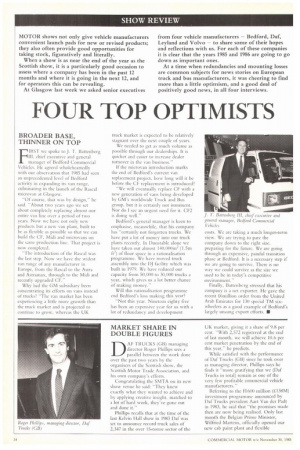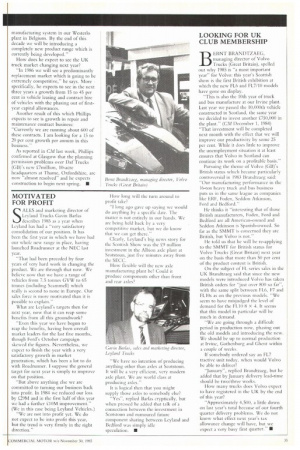FOUR TOP OPTIMISTS
Page 36

Page 37

If you've noticed an error in this article please click here to report it so we can fix it.
BROADER BASE, THINNER ON TOP
F1RST we spoke to J. T. Battenberg Ill, chief executive and general manager of Bedford Commercial Vehicles. He agreed wholeheartedly with our observation that 1985 had seen an unprecedented level of Bedford activity in expanding its van range, culminating in the launch of the Rascal microvan at Glasgow.
"Of course, that was by design," he said. "About two years ago we set about completely replacing almost our entire van line over a period of two years. Now we have not only new products but a new van plant, built to he as flexible as possible so that we can build the CF. Midi and microvans on the same production line. That project is now completed.
-The introduction of the Rascal was the last step. Now we have the widest van range of any manufacturer in Europe, from the Rascal to the Astra and Astratnax, through to the Midi and recently upgraded CF."
Why had the GM subsidiary been concentrating its efforts on vans instead of trucks? "The van market has been experiencing a little more growth than the truck market and is projected to continue to grow. whereas the UK truck market is expected to be relatively stagnant over the next couple of years.
We needed to get as much volume as possible through our dealerships. It is quicker and easier to increase dealer turnover in the van business," If the microvan introduction marks the end of Bedford's current van replacement project, how long will it be before the CF replacement is introduced?
"We will eventually replace CF with a new generation of vans being developed by GM's worldwide Truck and Bus group, but it is certainly not imminent. Nor do I see an urgent need for it. CF2 is doing well.
Bedford's general manager is keen to emphasise, meanwhile, that his company has "certainly not forgotten trucks. We have put a lot of money into our truck plants recently. In Dunstable alone we have taken out almost 140,000m2 (1.5m ft2) of floor space in a rationalisation programme. We have moved truck assembly into the DJ facility which was built in 1979. We have reduced our capacity from 50,000 to 30,000 trucks a year, which gives us a lot better chance of making money.
Will this rationalisation programme end Bedford's loss making this year?
"Not this year. Nineteen eighty five has been an expensive year for us with a lot of redundancy and development
costs. We are taking a much longer-term view. We are trying to pare the company down to the right size, preparing for the future. We are going through an expensive, painful transition phase at Bedford. It is a necessary step if we are going to survive. There is no way we could survive as the size we used to be in today's competitive environment.
Finally, Battenberg stressed that his company is a net exporter. He gave the recent f.6million order from the United Arab Emirates for 130 special TM sixwheelers as a good example of Bedford's largely unsung export efforts. •
MARKET SHARE IN DOUBLE FIGURES
DAF TRUCKS (GB) managing director Roger Phillips sees a parallel between the work done over the past two years by the organisers of the Scottish show, the Scottish Motor Trade Association, and his own company's eilbrts.
Congratulating the SMTA on its new show venue he said: "They knew exactly what they wanted to achieve and by applying creative insight, matched to a lot of hard work, they've gone out and done it."
Phillips recalls that at the time of the last Kelvin Ilall show in 1983 Daf was set to announce record truck sales of 2,347 in the over 15-tonne sector of the UK market, giving it a share o19.8 per cent. "With 2,572 registered at the end of last month, we will achieve 10.6 per cent market penetration by the end of this year," he predicts.
While satisfied with the performance of Dal Trucks (GB) since he took over as managing director, Phillips says he finds it "more gratifying that we (Daf Trucks in total) remain as one of the very few profitable commercial vehicle manufacturers."
Rekrring to the Fl 600 million (i.138M) investment programme announced by Daf Trucks president Aart Van der Padt in 1983, he said that "the promises made then are now being realised. Only last month the Belgian Prime Minister, Wilfried Martens, officially opened our new cab paint plant and flexible manufacturing system in our Westerlo plant in Belgium. By the end of this decade we will be introducing a completely new product range which is currently being developed."
How does he expect to see the UK truck market changing next year?
"In 1986 we will see a predominantly replacement market which is going to be extremely competitive," he says. More specifically, he expects to see in the next three years a growth front 15 to 45 per cent in vehicle leasing and contract hire of vehicles with the phasing out of firstyear capital allowances.
Another result of this which Phillips expects to see is growth in repair and maintenance contract business: "Currently we are running about 6(X) of these contracts. I am looking for a 15 to 20 per cent growth per annum in this business."
As reported in CM last week, Phillips confirmed at Glasgow that the planning permission problems over Daf Trucks (GB)'s new £7million, 10-acre headquarters at Tharne, Oxfordshire, are now "almost resolved" and he expects construction to begin next spring. •
MOTIVATED FOR PROFIT
SALES and marketing director of Leyland Trucks Gavin Barlas describes 1985 as a year when Leyland has had a "very satisfactory consolidation of our position. It has been the first year in which we have had our whole new range in place, having launched Roadrunner at the NEC last year.
"That had been preceded by four years of very hard work in changing the product. We are through that now. We believe now that we have a range of vehicles from 7.3 tonnes GVW to 65 tonnes (including Scammell) which really is second to none in Europe. Our sales force is more motivated than it is possible to explain.
What are Leyland's targets then for next year, now that it can reap some benefits from all this groundwork?
"Even this year we have begun to reap the benefits, having been overall market leaders for the last five months, though Ford's October campaign skewed the figures. Nevertheless, we expect to finish the year with a very satisfactory growth in ill:Irket penetration, which has been a lot to do with Roadrunner. I suppose the general target for next year is simply to improve on that position.
But above anything else we are committed to turning our business hack into profit. In 1984 we reduced our loss by .''.29M and in the first half of this year we had a further 1:10M improvement." (We in this case being Leyland Vehicles.) "We are not into profit yet. We do not expect to be into profit this year, but the trend is very firmly in the right direction.'' How long will the turn around to profit take?
"1 long ago gave up saying we would do anything by a specific date. The matter is not entirely in our hands. We are being held back by a very competitive market, but we do know that we can get there."
Clearly, Leyland's big news story for the Scottish Show was the £9 million investment in the Albion axle plant at Seotstoun, just five IllintItCS away from the SECC.
How flexible will the new axle manufacturing plant be? Could it produce components other than front and rear axles?
"We have no intention of producing anything other than axles at Scotstoun. It will be a very efficient, very modern axle plant. We are world class at producing axles."
It is logical then that you might supply those axles to somebody else?
"Yes", replied Barlas cryptically, but when pressed he added that talk of a connection between the investment in Scotstoun and rumoured future component sharing between Leyland and Bedford was simply idle speculation. •
LOOKING FOR UK CLUB MEMBERSHIP
BERNT BRANDTZAEG, managing director of Volvo Trucks (Great Britain), spelled out why 1985 is "a most important year" for Volvo: this year's Scottish show is the first British exhibition at which the new FL6 and FL7/10 models have gone oti display.
"This is also the 10th year of truck and bus manufacture at our Irvine plant. Last year we passed the 10,000th vehicle constructed in Scotland, the same year we decided to invest another 050,000 in the plant.(CM December 1, 1984) ''That investment will be completed next month with the effect that we will improve our productivity by some 25 per cent. While it does little to improve the unemployment situation it at least ensures that Volvo in Scotland can continue its work on a profitable basis."
Pursuing the theme of Volvo (GB)'s British status which because particularly controversial in 1983 Brandtzaeg said: "Our manuilicturing performance in the 16-ton heavy truck and bus business puts us in the same league as companies like ERF, Foden, Seddon Atkinson, Ford and Bedford."
He thinks it "interesting that of those British manufacturers, Foden, Ford and Bedford are all American-owned and Seddon Atkinson is Spanish-owned. So far as the SMMT is concerned they arc British, but Volvo is not."
He told us that he will be re-applying to the SMMT for British status for Volvo Trucks (Great Britain) next year on the basis that more than 50 per cent of the product content is British.
On the subject of FL series sales in the UK Brandtzaeg said that since the new models were introduced Volvo has taken British orders for "just over 800 so far", with the same split between FL6, F7 and I'LlOs as on the previous models. "We seem to have misjudged the level of demand for the FL10 8 x 4. It seems that this model in particular will be much in demand.
"We are going through a difficult period in production now, phasing out the old models and introducing the new. We should be up to normal production at Irvine, Gothenburg and Ghent within a couple of weeks, If somebody ordered say an FL7 tractive unit today, when would Volvo be able to deliver?
"January", replied Brandtzaeg, but he added that by January delivery lead-time should be two/three weeks.
How many trucks does Volvo expect to have registered in the UK by the end of this year?
"Approximately 4,500, a little down on last year's total because of our fourth quarter delivery problems. We do not know what effect next year's tax allowance change will have, but we expect a very busy first quarter." •
























































































